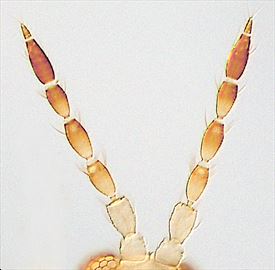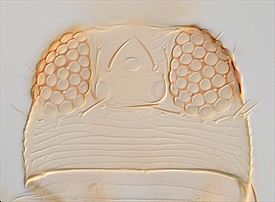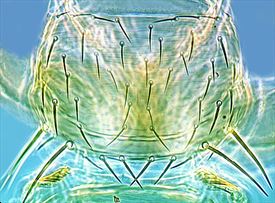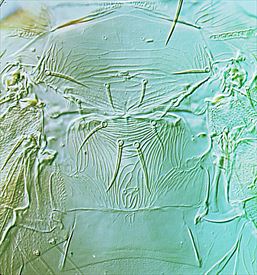Distinguishing features
Both sexes fully winged. Female body and legs yellow, major setae light brown; antennal segments IV–V brown distally, VI–VII brown; fore wings pale. Antennae 7-segmented, III–IV slightly constricted at apex, VII short. Head wider than long, ocellar setae pair III small and arising just outside ocellar triangle; postocular setae pair I slightly longer than ocellar setae III. Pronotum with 2 pairs of long postero-angular setae, posterior margin with 3 pairs of setae. Metanotum with irregular longitudinal lines converging to posterior margin, with curving transverse lines at anterior; median setae arising behind anterior margin, campaniform sensilla present. Fore wing first vein with 3 (or 2) setae on distal half, second vein with row of about 15 setae. Tergite II with 4 lateral marginal setae; posterior margin of tergite VIII with complete comb of long slender microtrichia. Sternites and pleurotergites without discal setae, pleurotergal sculpture lines without microtrichia.
Male similar to female but smaller; tergite VIII with marginal comb complete medially; sternites III–VII with narrow transverse pore plate.
Related species
There are 13 species of the genus Thrips recorded from New Zealand, out of a total of 280 species worldwide (Mound & Masumoto, 2005). Many of these species have the antennae clearly 7-segmented, whereas others have 8 segments. All members of Thrips genus have paired ctenidia on the tergites, and on tergite VIII these are postero-mesad to the spiracles, and they also lack ocellar setae pair I in front of the first ocellus. In contrast, Frankliniella species have ctenidia on tergite VIII antero-lateral to the spiracles, and a pair of setae is always present in front of the first ocellus. T. palmi is very similar in structure to the common Holarctic species, T. flavus, but in that species ocellar setae pair III are close together behind the first ocellus and within the ocellar triangle.
Biological data
Feeding and breeding in flowers and on leaves, this polyphagous thrips is particularly common on crops of Cucurbitaceae and Solanaceae, also cultivated Orchids. It is a major pest on several crops, both through direct feeding damage and as a tospovirus vector.
Distribution data
Not recorded from New Zealand, but considered a high risk potential invader. Originally from Asian tropics but now widespread in tropical countries, including northern Australia.
Family name
THRIPIDAE, THRIPINAE
Species name
Thrips palmi Karny
Original name and synonyms
Thrips palmi Karny, 1925: 10
Thrips clarus Moulton, 1928: 294
Thrips leucadophilus Priesner, 1936: 91
Thrips gossypicola Priesner, 1939: 41
Chloethrips aureus Ananthakrishnan & Jagadish, 1967: 381
Thrips gracilis Ananthakrishnan & Jagadish, 1968: 361
References
Mound LA & Masumoto M (2005) The genus Thrips (Thysanoptera, Thripidae) in Australia, New Caledonia and New Zealand. Zootaxa 1020: 1–64.
Mound LA, Tree DC & Paris D (2012) OzThrips – Thysanoptera in Australia. http://www.ozthrips.org/





